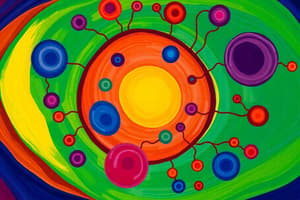Podcast
Questions and Answers
Which organelle is primarily responsible for energy production in a cell?
Which organelle is primarily responsible for energy production in a cell?
- Nucleus
- Chloroplast
- Vacuole
- Mitochondria (correct)
What is the main function of the cell membrane?
What is the main function of the cell membrane?
- Provide structural support
- Control the movement of substances in and out of the cell (correct)
- Transport nutrients and waste
- Store genetic information
What major system in the body is responsible for oxygen transport?
What major system in the body is responsible for oxygen transport?
- Respiratory system (correct)
- Nervous system
- Digestive system
- Excretory system
Which part of the circulatory system is primarily responsible for filtering waste from the blood?
Which part of the circulatory system is primarily responsible for filtering waste from the blood?
What is the primary purpose of cilia in the digestive system?
What is the primary purpose of cilia in the digestive system?
What is the primary role of the vacuole in a cell?
What is the primary role of the vacuole in a cell?
Which statement accurately describes the purpose of the digestive system?
Which statement accurately describes the purpose of the digestive system?
What is the main function of the mitochondria?
What is the main function of the mitochondria?
Which organ is primarily responsible for filtering blood in the excretory system?
Which organ is primarily responsible for filtering blood in the excretory system?
What is the function of the chloroplast in plant cells?
What is the function of the chloroplast in plant cells?
Flashcards
What is a cell?
What is a cell?
The basic unit of all living things, responsible for carrying out all life processes.
What is the nucleus?
What is the nucleus?
The control center of the cell, containing DNA which carries the genetic code for the organism.
What is digestion?
What is digestion?
The process of breaking down food into smaller molecules that the body can absorb and use for energy.
What is the excretory system?
What is the excretory system?
Signup and view all the flashcards
What are cilia?
What are cilia?
Signup and view all the flashcards
What is an organelle?
What is an organelle?
Signup and view all the flashcards
What is the circulatory system?
What is the circulatory system?
Signup and view all the flashcards
Study Notes
Cell Structure and Function
- Cells are the fundamental units of all living things.
- Cell theory outlines the key principles of cells.
- Key organelles and their functions include:
- Nucleus: Controls cell activities.
- Cell membrane: Regulates what enters and exits the cell.
- Vacuole: Stores water and other substances.
- Chloroplast: Site of photosynthesis in plant cells.
- Mitochondria: Powerhouse of the cell, produces energy.
- Cytoplasm: Jelly-like substance filling the cell.
- Cell Wall: Rigid outer layer, supports plant cells.
- Specialized structures exhibit unique functions, depending on the cell's role.
- Understanding the importance of each cell part is crucial.
- Identify cell structures and organelles from diagrams.
Introduction to Body Systems
Respiratory System
- Main organs include lungs and airways.
- Responsible for gas exchange, taking in oxygen and releasing carbon dioxide.
- Crucial for oxygen transport throughout the body.
- Identifying the purpose of the respiratory system is essential.
Digestive System
- Organs involved include mouth, esophagus, stomach, intestines, etc.
- Breaks down food into absorbable nutrients.
- Facilitates nutrient absorption.
- The purpose of the digestive system is nutrient breakdown and absorption.
Circulatory System
- Heart, blood vessels (arteries, veins, capillaries), and blood are essential.
- Transports oxygen, nutrients, and waste products throughout the body.
- The function of the circulatory system is transport.
Excretory System
- Kidneys, bladder, and other organs remove waste products from the blood.
- Maintains the body's internal balance (homeostasis).
- The excretory system's function is waste removal.
Nervous System
- Brain, spinal cord, and peripheral nerves facilitate communication, response to stimuli, and adaptation to environmental changes.
- The nervous system's purpose is communication and response to changes.
Systems and Your Health
- Blood composition includes red blood cells, white blood cells, and platelets.
- A sphygmomanometer measures blood pressure (differing from a stethoscope which detects internal sounds).
- Blood pressure indicates the force of blood against artery walls.
- Common causes of circulatory disorders include high blood pressure and heart disease.
- A healthy diet comprises various essential nutrients.
- Cilia are tiny hair-like structures found in various systems, promoting movement.
Studying That Suits You
Use AI to generate personalized quizzes and flashcards to suit your learning preferences.



